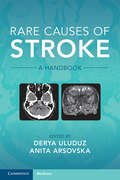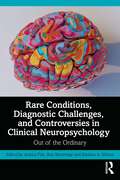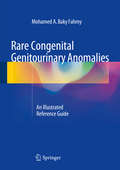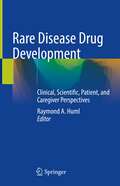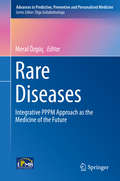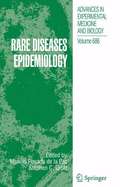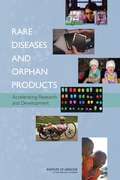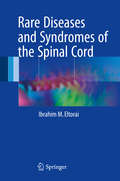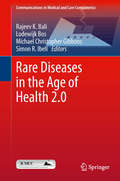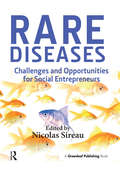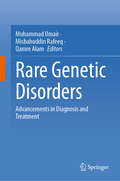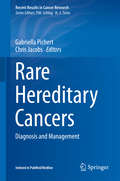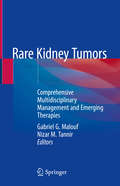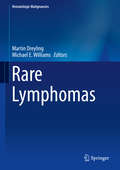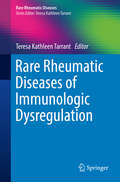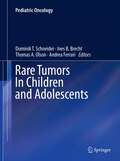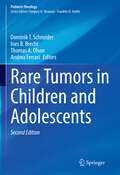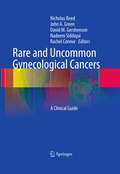- Table View
- List View
Raquela: A Woman of Israel
by Ruth GruberA National Jewish Book Award–winning biography: A look at the early years of Israel&’s statehood, experienced through the life of a pioneering nurse.During her extraordinary career, nurse Raquela Prywes was a witness to history. She delivered babies in a Holocaust refugee camp and on the Israeli frontier. She crossed minefields to aid injured soldiers in the 1948 Arab-Israeli War and organized hospitals to save the lives of those fighting the 1967 Six-Day War. Along the way, her own life was a series of triumphs and tragedies mirroring those of the newly formed Jewish state.Raquela is a moving tribute to a remarkable woman, and an unforgettable chronicle of the birth of Israel through the eyes of those who lived it.
Raquela: A Woman of Israel
by Ruth GruberA National Jewish Book Award–winning biography: A look at the early years of Israel&’s statehood, experienced through the life of a pioneering nurse.During her extraordinary career, nurse Raquela Prywes was a witness to history. She delivered babies in a Holocaust refugee camp and on the Israeli frontier. She crossed minefields to aid injured soldiers in the 1948 Arab-Israeli War and organized hospitals to save the lives of those fighting the 1967 Six-Day War. Along the way, her own life was a series of triumphs and tragedies mirroring those of the newly formed Jewish state.Raquela is a moving tribute to a remarkable woman, and an unforgettable chronicle of the birth of Israel through the eyes of those who lived it.
Rare Causes of Stroke: A Handbook
by Anita ArsovskaStroke is the second leading cause of death and major cause of long-term disability, directly impacting the quality of life, worldwide. Strokes with more rare, and unknown causes unfortunately receive little to no attention due to the heterogeneity of disorders and a poor understanding of clinical features. There are considerable variations in the etiology of this rare sub-category of stroke; requiring heightened clinical awareness for recognition, evaluation and treatment. This book provides up-to-date guidance, through case reports concisely summarised by global leaders in the field describing the diagnosis and treatment of rare causes of stroke, from vasculitis, hypercoagulable states, hereditary and genetic factors, cardioembolism, vasculopathies, venous occlusive conditions to bone disorders. Offering practical advice and algorithms, this book aids the clinician in establishing an accurate diagnosis through detailed evaluation of such patients, leading to an early diagnosis improving risk assessment and family counselling.
Rare Conditions, Diagnostic Challenges, and Controversies in Clinical Neuropsychology: Out of the Ordinary
by Barbara A. Wilson Shai Betteridge Jessica FishThis book highlights those rare, difficult to diagnose or controversial cases in contemporary clinical neuropsychology. The evidence base relevant to this type of work is almost by definition insufficient to guide practice, but most clinicians will encounter such cases at some point in their careers. By documenting the experiences and learning of clinicians who have worked with cases that are ‘out of the ordinary’, the book addresses an important gap in the literature. The book discusses 23 challenging and fascinating cases that fall outside what can be considered routine practice. Divided into three sections, the text begins by addressing rare and unusual conditions, defined as either conditions with a low incidence, or cases with an atypical presentation of a condition. It goes on to examine circumstances where an accurate diagnosis and/or coherent case formulation has been difficult to reach. The final section addresses controversial conditions in neuropsychology, including those where there is ongoing scientific debate, disagreement between important stakeholders, or an associated high-stakes decision. This text covers practice across lifespan and offers crucial information on specific conditions as well as implications for practice in rare disorders. This book will be beneficial for clinical neuropsychologists and applied psychologists working with people with complex neurological conditions, along with individuals from medical, nursing, allied health and social work backgrounds. It will further be of appeal to educators, researchers and students of these professions and disciplines.
Rare Congenital Genitourinary Anomalies
by Mohamed A. Baky FahmyPatients with rare diseases, affecting less than 1 in 2000 persons, frequently experience delays or errors in diagnosis, sometimes with tragic consequences. Even after the diagnosis has been established, the quality of health care delivered is often poor. This book, which is both textbook and atlas, covers the full range of rare congenital genitourinary anomalies encountered in males and females, many of which have previously been described only in sporadic case reports. In the case of the more established anomalies, variants are presented. For each anomaly, information is provided on incidence, similar cases, clinical presentation, diagnosis, possible management and outcome. Informative supporting illustrations are presented for each anomaly, and the book will serve as an excellent reference for all pediatricians, urologists and surgeons who are responsible for the care of such patients.
Rare Disease Drug Development: Clinical, Scientific, Patient, and Caregiver Perspectives
by Raymond A. HumlThis book provides a broad overview of rare disease drug development. It offers unique insights from various perspectives, including third-party capital providers, caregivers, patient advocacy groups, drug development professionals, marketing and commercial experts, and patients. A unique reference, the book begins with narratives on the many challenges faced by rare disease patient and their caregivers. Subsequent chapters underscore the critical, multidimensional role of patient advocacy groups and the novel approaches to related clinical trials, investment decisions, and the optimization of rare disease registries. The book addresses various rare disease drug development processes by disciplines such as oncology, hematology, pediatrics, and gene therapy. Chapters then address the operational aspects of drug development, including approval processes, development accelerations, and market access strategies. The book concludes with reflections on the authors' case for real-world data and evidence generation in orphan medicinal drug development. Rare Disease Drug Development is an expertly written text optimized for biopharmaceutical R&D experts, commercial experts, third-party capital providers, patient advocacy groups, patients, and caregivers.
Rare Diseases
by Meral ÖzgüçThis book focuses on predictive, preventative and personalized medicine (PPPM) and how it is related to the healthcare of rare diseases. Readers will discover how advanced rare diseases healthcare provides an excellent "proof-of-principles" for the personalisation of healthcare systems on a global scale. Chapters look at national plans for rare disease, at biobanking, gene identification, rare cancers, virus gene therapy , induced pluripotency for cell therapy amongst other topics. There is a chapter dedicated to personalized medicine for hereditary deafness and another exploring the complexity of genotype-phenotype correlations. Specific diseases such as Fabry's, Gauchers and mitochondrial cytopathies are highlighted and we look at enzyme replacement therapy in lysosomal storage diseases. This work is part of a series, produced with the involvement of the European Association for Predictive, Preventive and Personalised Medicine. The series focusses on the concept of an integrative medical approach by PPPM. This volume is dedicated to all aspects related to the prediction, prevention and personalised treatments of rare diseases, and in doing so it explores developments relevant to all medical branches. The authors cover ethical considerations, the creation of a robust platform for professional communication, synergies with patient organisations, "doctor-patient" collaboration and a new philosophy of integrative medicine by PPPM. This volume serves as a reference source for scientific and medical centres in the field and can be used both at medical curricula and graduate level in the life sciences. Those who place a special emphasis on healthcare promotion and innovations intended to combat rare diseases, save the affected lives and enhance life quality will all find this book of great value.
Rare Diseases Epidemiology
by Manuel Posada de la Paz Stephen C. GroftThe Rare Diseases Epidemiology book is a comprehensive text focused on the rare disease field where both general epidemiological methods and specific methods for low prevalence diseases are discussed. This is the first book to address rare diseases as a public health problem where the epidemiological research constrains are analyzed and at the same time, solutions and also data by rare diseases groups are provided. This book is probably a starting point for developing better future epidemiological research programs on rare diseases, and also research strategies in fields such as health planning and decision making, which will be able to promote not only new knowledge but also capacity building for policy makers. Epidemiology is always mentioned in all rare diseases policy documents as an important topic but a comprehensive book on this discipline applied to rare diseases, had never been written before.
Rare Diseases and Orphan Products: Accelerating Research and Development
by Institute of Medicine of the National AcademiesRare diseases collectively affect millions of Americans of all ages, but developing drugs and medical devices to prevent, diagnose, and treat these conditions is challenging. The IOM recommends implementing an integrated national strategy to promote rare diseases research and product development.
Rare Diseases and Syndromes of the Spinal Cord
by Ibrahim M. EltoraiThis book provides a comprehensive and up-to-date review of rare diseases and syndromes of the spinal cord, collected over the past forty years from all the world's literature. Each chapter in this volume is organized in the same easy-to-follow format, comprising definitions, incidence, etiology, clinical presentation, diagnosis, management, prognosis, and references. This book is aimed at medical students, residents, fellows, and junior attendings in spinal cord medicine, physical medicine, neurosurgery, orthopedics, oncology, emergency medicine, infectious disease, neurology, genetics, vascular surgery, and endocrinology, along with the numerous allied fields of physical therapy, nursing, occupational therapy, and biomedical researchers.
Rare Diseases in the Age of Health 2.0
by Michael Christopher Gibbons Lodewijk Bos Rajeev K. Bali Simon IbellThis text focuses on various factors associated with orphan diseases and the influence and role of health information technologies. Orphan diseases have not been adopted by the pharmaceutical industry because they provide little financial incentive to treat or prevent it. It is estimated that 6,000-7,000 orphan diseases exist today; as medical knowledge continues to expand, this number is likely to become much greater. The book highlights the opportunities and challenges in this increasingly important area. The book explores new avenues which are opened by information technologies and Health 2. 0, and highlights also economic opportunities of orphan disease medicine. The editors of this new book have international experience and competencies in the key areas of patient empowerment, healthcare and clinical knowledge management, healthcare inequalities and disparities, rare diseases and patient advocacy.
Rare Diseases: Challenges and Opportunities for Social Entrepreneurs
by Nicolas SireauThere are 7,000 rare diseases affecting 6%–8% of the global population. That's 3.5 million people in the UK alone. Yet only 200 rare diseases have approved treatments. In recent years, there has been a surge of interest from business and social entrepreneurs in the field of health – including looking at ways to treat rare disease patients better and faster. This book presents some of the latest developments in the world of rare disease entrepreneurship from a global group of experts. It examines the topic from the business angle, considering the drug development process and providing case studies of successful orphan drug enterprises. It also looks at rare diseases from the perspective of the patient, analysing the growing rare disease patient movement, a successful patient group that uses social enterprise techniques, and chapters on key requirements for helping patients with rare diseases through registries and centres of excellence. The book will be an essential toolkit for social and business entrepreneurs who are interested in the world of rare/orphan diseases. It has the rigour of an academic publication, along with the clarity of a lay publication. An original and timely book, Rare Diseases will help to add knowledge and awareness to a vastly under-published subject.
Rare Genetic Disorders: Advancements in Diagnosis and Treatment
by Muhammad Umair Misbahuddin Rafeeq Qamre AlamThis book introduces different Rare Genetic Disorders (RGDs), and challenges in their diagnosis. The chapters of the book discuss the emerging research and clinical approaches for the diagnosis of rare genetic disorders. It further reviews the future of genetic therapies for the treatment of rare genetic diseases and examine the recent advancements in the field of genetic testing for the diagnosis of these diseases. The book also covers the role of variants in the genome (genetic modifiers) that alleviate (suppress) or exacerbate (enhance) the severity of the disease, resulting in the variability of phenotypic outcomes. Further, the book examines different animal models for critical understanding of disease mechanisms, and the opportunity to evaluate the effect of therapeutic compounds in pre-clinical studies. The subsequent chapters present the state-of-the-art drug discovery strategies and biological approaches for the treatment of rare genetic disorders. Towards the end, the book reviews the current challenges in the diagnosis and treatment of the patients of rare genetic disorders and future opportunities. This book is useful for clinical geneticists, molecular and biochemical geneticists, researchers working in gene therapy and genome editing.
Rare Genitourinary Tumors
by Lance PagliaroRare Genitourinary Tumors offers the reader an up-to-date discussion of the less common neoplasms affecting the urinary tract and reproductive organs. Each authoritative chapter provides and in-depth discussion that is frequently not found in other urologic oncology textbooks. A valuable reference for urologists, oncologists, and those in specialty training, this volume provides ready access to information on etiology, incidence, risk factors, diagnosis, prognosis, insights from molecular pathology and, where applicable, data from clinical trials. The practical treatment guidelines included for each tumor type are written by experts and fully referenced.
Rare Hereditary Cancers
by Gabriella Pichert Chris JacobsThis book approaches the differential diagnosis and management of rare, hereditary cancer syndromes from a practical angle, addressing the issues pertinent to each tumour type as encountered by health professionals in their day-to-day practice. This book enables readers to correctly identify patients with rare cancer syndromes who would benefit from genetic counselling and testing, and provides the necessary knowledge for appropriate patient management and advising at-risk family members. It begins by describing recent advances in genetic testing for cancer-predisposing genes. Leading experts from Europe and Australia then offer detailed, up-to-date guidance on the diagnosis and management of a wide range of hereditary cancers. The concluding chapter examines the wider issues that are raised by genetic testing for rare cancer syndromes for patients, families and health professionals. This book is an invaluable source of information for all specialists involved in the care of such patients and their families.
Rare Kidney Tumors: Comprehensive Multidisciplinary Management and Emerging Therapies
by Gabriel G. Malouf Nizar M. TannirThis book provides clinicians with clear guidance on treatment decision-making in patients with rare kidney cancers. After a brief review on epidemiology, pathology, and biology, each chapter focuses on the multidisciplinary management of a particular tumor subtype using the full range of available cancer therapy modalities, including surgery, radiotherapy, chemotherapy, targeted therapies, and immunotherapy. Emerging therapies and future directions in the management of each cancer subtype are also discussed. The chapters are all written by multidisciplinary teams of international experts comprising at least a urologist, a medical oncologist, and a pathologist. Rare kidney cancers represent 15% of renal cell carcinomas. In comparison with clear cell renal cell carcinomas, little is known about the biology of such cancers, and few trials have reported on the efficacy of targeted therapies in the metastatic setting. Optimal management thus poses significant challenges and often requires a multidisciplinary team. This book will be an ideal reference guide for all clinicians involved in the care of patients with these orphan tumors.
Rare Lung Diseases: A Comprehensive Clinical Guide to Diagnosis and Management
by Anupam Kumar Sujith V. CherianThis book aims to be a complete guide to diagnose, manage, and treat rare lung diseases encountered by practicing pulmonologists and trainees. It extensively covers the "more common" of the rare lung diseases, categorizing them based on developmental lung anomalies in adults, airway disorders, diffuse parenchymal lung diseases, neoplasms, rare vascular disorders, and other miscellaneous conditions. This comprehensive review facilitates the study and understanding of this complex and diverse set of disorders, focusing on differential diagnosis, evidence-based discussions of management algorithms, and thoughtful analysis of treatment options. Key Features * Reviews multiple rare lung diseases, including ones acquired congenitally to be expressed in old age * Enriched with case studies and illustrations to guide respiratory physicians and trainees to devise an effective treatment plan *Focuses on concerned investigations, with a section on the role of new procedures in management
Rare Lymphomas
by Michael E. Williams Martin DreylingAfter a decade of tremendous progress in the diagnostic and therapeutic approaches to malignant lymphoma, optimal treatment strategies are now based not only on accurate diagnosis but also on thorough evaluation of clinical and molecular risk factors. Even more importantly, molecular targeted approaches have been shown to be effective in the treatment of distinct lymphoma subtypes. Against this background, clinical management of especially the rare lymphomas remains a challenge for the general oncologist. This book provides a comprehensive overview of current treatment strategies in these rare lymphoma subtypes. Experts in the field from around the world describe histomorphology in a clinically relevant manner, consider the role of risk factors in detail, and discuss the spectrum of therapeutic approaches. Special emphasis is placed on the translation of molecular science into clinical care, and a disease-specific algorithm is proposed for each entity.
Rare Malignant Skin Tumors
by Franco Rongioletti Irina Margaritescu Bruce R SmollerThis book provides practitioners with a single volume that reviews the clinical and pathologic features of rarely encountered cutaneous neoplasms. The text includes an in-depth discussion of the clinical findings, as well as the histologic and immunologic features of these diseases that are rarely encountered, reported, or recognized. Additional laboratory data used to make and support the diagnoses with some therapeutic and prognostic hints are discussed for each entity. The volume is organized into general categories correlating with the cell(s) of origin. An atlas of clinical manifestations is presented for each entity that will serve as a bedside clinical reference, followed by a series of photomicrographs depicting the histologic changes. In all cases, recent updates on molecular tools helpful in attaining the diagnosis are added to the sections on histology and immunohistochemistry. Rare Malignant Skin Tumors is a valuable bedside reference for the practicing dermatopathologist, general pathologist reviewing skin biopsies, general dermatologists, cutaneous oncologists and Mohs' surgeons.
Rare Rheumatic Diseases of Immunologic Dysregulation (Rare Rheumatic Diseases)
by Teresa Kathleen TarrantThis book is a practical, user-friendly guide for diagnosing and treating patients with rare rheumatic diseases of immunologic dysregulation. Covering uncommon diseases such as IgG4-Related Disease, Castleman’s Disease, and Felty Syndrome, chapters aggregate information from case reports and anecdotal literature to create a single, comprehensive handbook for treating patients. Each chapter provides historical perspective and epidemiology; a literature review (including research trials, translational research, historical and current case reports, and case series); pathogenesis; clinical presentation; laboratory evaluation; imaging; histopathology; treatment; and outcomes. Rare Rheumatic Diseases of Immunologic Dysregulation is an invaluable resource for rheumatologists, rheumatology fellows, and clinical immunologists to better diagnose and treat patients with rare rheumatic diseases.
Rare Sarcomas
by Christine Chevreau Antoine ItalianoThis is a unique book focusing on the management of rare sarcomas, which pose an important challenge in Europe and in the US, as they represent nearly one quarter of all new diagnoses of cancer and have lower survival rates than common cancer. Discussing a range of tumors from clear cell and epithelioid sarcoma to solitary fibrous tumor and myxoid fibrosarcoma, this book provides invaluable expertise according to evidence-based guidelines and uses a patient-centered multi-disciplinary approach.Each of the chapters discusses the forms of rare sarcomas both from an oncological and a pathological perspective. This book aims to help the sarcoma expert in improving the management, quality of care and outcome for patients with rare tumors, which have now been recognised as a public health priority.The authors are experts from specialist sarcoma centers focusing on the capacity to develop clinical guidelines, and to foster clinical, translational and epidemiological research for rare cancers.
Rare Tumors In Children and Adolescents
by Ines B. Brecht Dominik Schneider Thomas A. Olson Andrea FerrariThis is the first book to be devoted exclusively to rare tumors in children and adolescents, and its aim is to provide up-to-date information on their diagnosis and clinical management. The opening section addresses general issues including epidemiology, risk factors/etiology, biology and genetics, early detection, and screening. It also discusses solutions to assist in the management of rare tumors, such as international networking and internet platforms. In the second section, specific malignancies are described, with practical guidance on diagnostic workup, multimodal therapy, follow-up, and adverse effects. Discussion of differential diagnosis encompasses both frequent and rare tumor types, which should enable the clinician to take rare entities into account during the diagnostic assessment. Each chapter goes on to provide detailed therapeutic guidelines for specific rare tumors. The authors are a multidisciplinary group of specialists who have dedicated themselves to this group of tumors.
Rare Tumors and Tumor-like Conditions in Urological Pathology
by Liang Cheng Antonio Lopez-Beltran Carmen L. Menendez Rodolfo MontironiThis book is a comprehensive guide to rare tumors and tumor-like conditions of the urinary system and male genital organs. It comprises five chapters, devoted to the kidney, bladder, prostate, testes, and penis. Each chapter begins with a brief overview of "common" tumors and tumor-like conditions and with a section on the classification of both common and rare entities. The main clinical, pathological, immunohistochemical, and molecular findings for each rare tumor or tumor-like condition are then described and discussed. Significant characteristics are also documented by representative high-quality illustrations, with emphasis on those aspects of most relevance to differential diagnosis. In addition, prognostic features are fully covered. Urological Pathology: Rare Tumors and Tumor-Like Conditions will be ideal source of core information and practical guidance for residents, fellows, pathologists, urologists, and oncologists.
Rare Tumors in Children and Adolescents (Pediatric Oncology)
by Ines B. Brecht Thomas A. Olson Andrea Ferrari Dominik T. SchneiderThis is the first book to be devoted exclusively to rare tumors in children and adolescents. The completely revised and updated second edition reflects the significant progress that has been accomplished as a result of intensified international networking, deeper implementation of novel diagnostic tools, and the advent of molecular targeted therapies. Readers will find practical guidance on all aspects of clinical management, including diagnostic workup, multimodal therapy, follow-up, and management of adverse effects. The discussion of differential diagnosis encompasses both frequent and rare tumor types, enabling clinicians to take rare entities into account during diagnostic assessment of childhood tumors. Detailed therapeutic recommendations, developed in an international consensus process, are provided for specific rare tumors. In addition, general issues such as epidemiology, etiology, risk factors, biology and genetics, early detection, and screening are fully covered. The book is written by an international and multidisciplinary group of specialists and will be an important compendium for all pediatric oncologists who care for patients with rare tumors.
Rare and Uncommon Gynecological Cancers
by David M. Gershenson John Alan Green Nadeem Siddiqui Nicholas Reed Rachel ConnorThis book is intended as a reference manual that will provide the busy clinician with up-to-date information on the diagnosis and treatment of uncommon and rare gynecological cancers. While standard textbooks briefly cover these tumors, this is intended as a more comprehensive yet easy-to-use guide. After opening chapters on epidemiology, pathology, and diagnostic imaging, the full range of infrequently encountered gynecological cancers (ovarian, uterine, cervical, vaginal, and vulval) is presented and discussed with the aid of high-quality illustrations. In each case, detailed attention is paid to both differential diagnosis and current treatment options. The book has been written by an international panel of experts and is the first to gather all the uncommon and rare gynecological cancers together within one volume.

